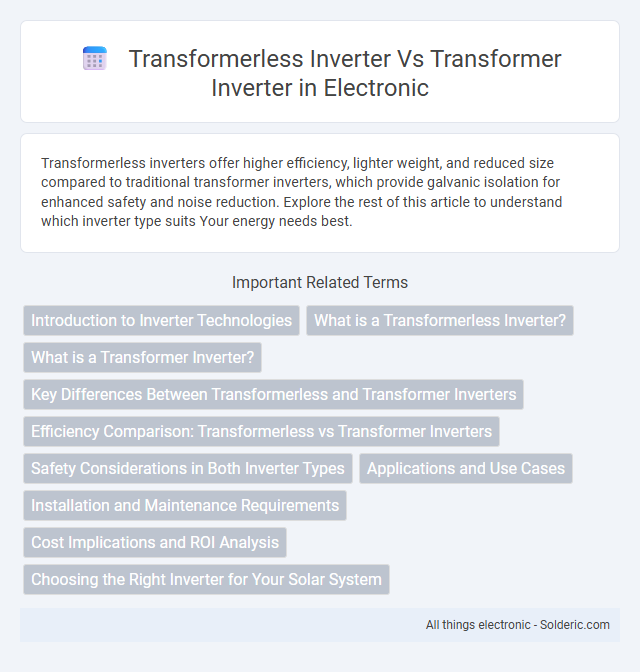Transformerless inverters offer higher efficiency, lighter weight, and reduced size compared to traditional transformer inverters, which provide galvanic isolation for enhanced safety and noise reduction. Explore the rest of this article to understand which inverter type suits Your energy needs best.
Comparison Table
| Feature | Transformerless Inverter | Transformer Inverter |
|---|---|---|
| Weight | Lightweight | Heavy |
| Efficiency | High (95-98%) | Lower (90-95%) |
| Cost | Lower initial cost | Higher initial cost |
| Size | Compact, smaller footprint | Larger, bulky due to transformer |
| Isolation | No galvanic isolation | Provides galvanic isolation |
| Safety | Requires additional safety measures | Intrinsic electrical isolation improves safety |
| Heat Generation | Lower heat loss | Higher heat generation |
| Application | Residential, commercial PV systems | Older systems, grid-tied with isolation requirements |
| Maintenance | Lower maintenance | Requires transformer upkeep |
| Reliability | High reliability with advanced electronics | Robust but bulkier components |
Introduction to Inverter Technologies
Transformerless inverters offer higher efficiency and lighter weight compared to traditional transformer inverters, as they eliminate bulky magnetic components that cause energy losses. Transformer inverters incorporate galvanic isolation through a transformer, enhancing system safety and reducing electrical noise but sacrificing efficiency and increasing size. Modern photovoltaic systems increasingly favor transformerless inverters for optimized energy conversion and reduced installation costs.
What is a Transformerless Inverter?
A transformerless inverter is a power conversion device used in solar photovoltaic systems that operates without a bulky transformer, resulting in higher efficiency and lighter weight. These inverters directly convert DC electricity from solar panels to AC electricity for the grid, minimizing power losses typically caused by transformers. Transformerless inverters are favored in residential and commercial solar installations for their compact design and improved energy yield.
What is a Transformer Inverter?
A transformer inverter uses a bulky magnetic core transformer to step up or step down voltage, providing galvanic isolation and voltage regulation. This type of inverter is reliable and offers better protection against electrical surges but is heavier and less efficient compared to transformerless inverters. Understanding the strengths of your inverter, like the robust isolation in transformer inverters, helps you choose the right solution for your energy needs.
Key Differences Between Transformerless and Transformer Inverters
Transformerless inverters are more efficient and lightweight, as they omit the bulky transformer used in transformer inverters, enabling better energy conversion rates and reduced system weight. Transformer inverters provide galvanic isolation, enhancing safety by electrically separating the DC and AC sides, which is crucial in sensitive or high-voltage applications. The choice depends on factors such as cost, efficiency, safety requirements, and system size, with transformerless models being favored for residential solar installations due to their higher efficiency and lower cost.
Efficiency Comparison: Transformerless vs Transformer Inverters
Transformerless inverters typically offer higher efficiency rates, often exceeding 98%, due to reduced energy loss from the absence of a heavy iron-core transformer. Transformer inverters experience conversion losses that lower overall efficiency, generally ranging between 94% and 96%, because of heat dissipation in the transformer coil. Your solar power system benefits from transformerless inverters through improved energy yield and reduced power wastage.
Safety Considerations in Both Inverter Types
Transformerless inverters offer higher efficiency and lighter weight but require advanced isolation techniques to ensure electrical safety due to the absence of galvanic isolation. Transformer inverters provide inherent safety by electrically isolating the input and output, reducing shock risk and electromagnetic interference. When selecting your inverter, consider the safety standards and installation environment to determine which type best protects users and equipment.
Applications and Use Cases
Transformerless inverters are widely used in residential and commercial solar PV systems due to their higher efficiency, lighter weight, and compact size, making them ideal for rooftop installations and limited-space environments. Transformer inverters are preferred in applications requiring galvanic isolation, such as grid-tied systems with stringent safety and grounding requirements, and where compatibility with older electrical infrastructure is necessary. Your choice depends on the need for isolation, installation constraints, and specific grid code compliance in your region.
Installation and Maintenance Requirements
Transformerless inverters offer a lightweight design that simplifies installation and reduces space requirements compared to traditional transformer inverters, which are bulkier and need more room for mounting. Maintenance for transformerless inverters is typically lower because they have fewer components susceptible to wear and overheating, whereas transformer inverters require regular inspection and servicing of the transformer to prevent failure. Choosing a transformerless inverter can optimize your system's efficiency and minimize ongoing maintenance costs.
Cost Implications and ROI Analysis
Transformerless inverters generally offer lower upfront costs due to their compact design and absence of bulky transformers, resulting in reduced material and manufacturing expenses. Your return on investment (ROI) improves with transformerless models because of higher efficiency, reduced energy losses, and lighter weight, which lowers installation and shipping costs. Transformer inverters, while more expensive and heavier, provide galvanic isolation that can enhance system safety and longevity, potentially affecting long-term maintenance costs but often diminishing immediate ROI compared to transformerless options.
Choosing the Right Inverter for Your Solar System
Transformerless inverters offer higher efficiency and lighter weight compared to transformer inverters, making them ideal for residential solar systems with limited space. Transformer inverters provide galvanic isolation, enhancing safety and compatibility with a wide range of solar panel configurations, preferred in industrial or commercial applications. Selecting the right inverter depends on factors like system size, budget, installation environment, and safety requirements to optimize performance and longevity.
transformerless inverter vs transformer inverter Infographic

 solderic.com
solderic.com